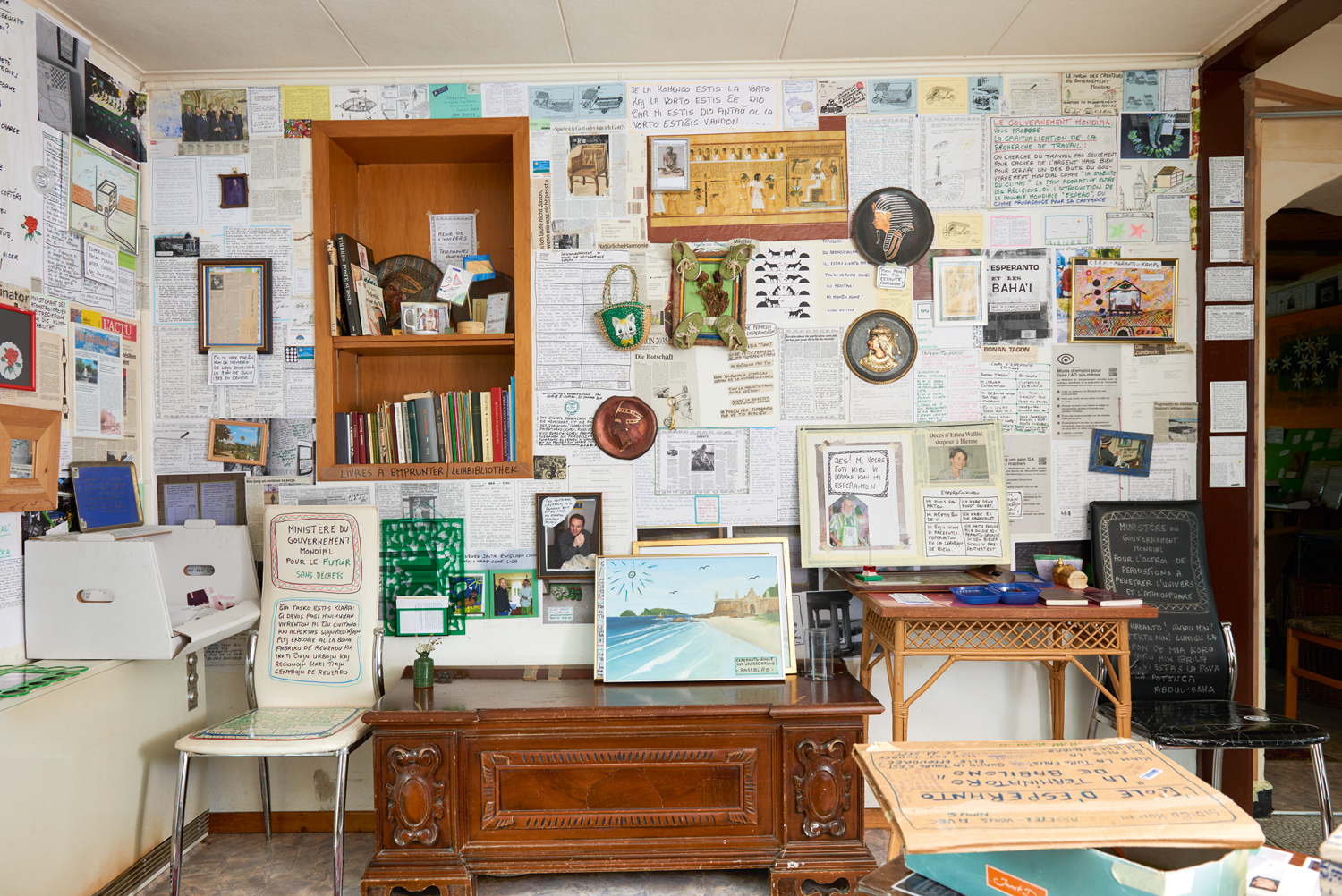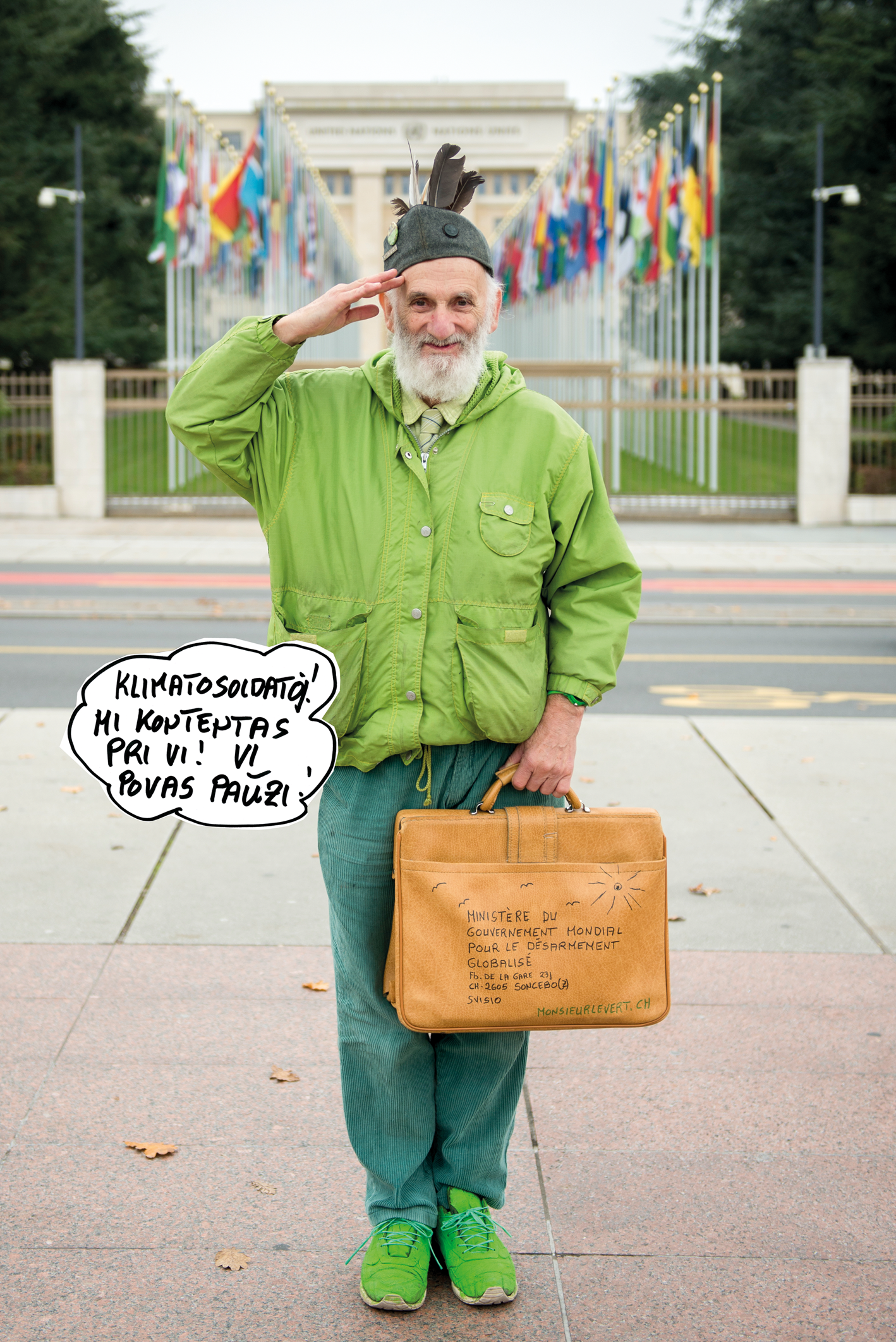Parzival’, self-appointed ‘Green Shoe Pharaoh’ and ‘Ambassador of the Sun’, is an Outsider Performance artist, whose performances are, however, no temporary projects, but an artistically created, on-going, life-long performance. He relinquished his given name and civil life, and created Parzival’, a timeless and ageless figure of art. Parzival’ is his work of art and his life all at once (Jagfeld and Haus am Gern, Reference Jagfeld and Haus am Gern2017; Parzival’ Monsieur le vert). His entire being and all his actions are dedicated to the goal of achieving world peace and promoting ecological awareness. To that effect, he founded his empire of the ‘World Government’ in Sonceboz, Switzerland. But Parzival's origin was not the intention of creating an art project. Parzival’ developed organically. The persona was born at a turning point in a middle-class existence, when his social self clashed with his spiritual self. Parzival’ embodies the birth of a new life emancipated from socially accepted norms.
In the report Das Leben und das Testament des Königs Parzival’ (The Life and Testament of King Parzival’), he describes the trajectory of his life filled with conflict (Parzival, n.d.). Parzival’ resists the norms of society and tests its limits early in life. He never completes his degree in mathematics and physics and he also drops out of his studies in economics. Still a young man, Parzival’ refuses military service in 1969. He is one of the first conscientious objectors in Switzerland, for which he is tried, convicted and imprisoned. His life reaches a turning point during a stay in a psychiatric clinic – ‘in the realm of chaos’. The writings of the religious founder of the Bahá’í faith, Baha'ullah, are a catalyst. He has a mystical experience that lasts for 3 days, during which his hand automatically shapes the name ‘Parzival’ and writes ‘Ta-O-Ra’ on a sheet of paper. ‘Parzival Ta-O-Ra’ – ‘Wisdom of the Sun’. Parzival’ later adds the apostrophe to his name as a sign of his incompleteness, with the intention of replacing the apostrophe with an ‘o’ in the future, once his global mission has been fulfilled. The adding of the ‘o’ would also complete his name in Esperanto. A key experience in his life is his encounter with the renowned pacifist and founder of the World Citizenship Movement, Garry Davis (1921–2013), who appoints him a soldier of the World Government. After Davis' death, Parzival’ declares himself to be the leader of the World Government. Today, his house in Sonceboz is the seat of the World Government, as well as a school for Esperanto (Meier, Reference Meier2001; Kaufmann, Reference Kaufmann2004; Parzival, 2016; Schleifenbaum, Reference Schleifenbaum2016).
Seldom has the term ‘life's work’ been more apt. Parzival's life choices are his work; his work is his life. ‘I have no personal identity, my mission is my identity’, he says. So how does Parzival's art manifest itself? He draws, paints on all sorts of things, writes, makes collages and builds several objects, transforms spaces into installations. He is a performer and an interventionist. For many years, he offered a bike taxi service and tried to use this as a means of gaining supporters for his mission. His house itself is designed as an art environment (Fig. 1). Parzival’ also consciously styles himself and is always dressed in green – the colour of photosynthesis, of hope and of the world language Esperanto. For his performances of the ‘Sun Theatre’ and ‘Blasphemy Duels’, he wears a pharaoh mask and sceptre. He is a politician who fights for world citizenship, an apostle of peace and a ‘climate soldier’ (Fig. 2). He is Bahá’í, believes in the equality of all world religions and is committed to practical ethics, a humanitarian vision of social development and social cohesion. He produces no rubbish, listens to the radio via an apparatus powered by a solar panel, which sits on his head like a hat. Parzival’ turns everything into an Esperanto peace course and invites all the powerful people of the world and especially all parties involved in the world's most tenacious conflicts to take a solidarity Esperanto course and hold peace talks at his headquarters of the World Government. He creates his own money, the Esperanto world currency, as well as postage stamps, identity cards and world citizen passports (Parzival Ta-O-Ra, 2009; Parzival’ at Thomas Hirschhorn's Robert Walser Sculpture, 2019).

Fig. 1. Parzival’s house in Sonceboz, the seat of the World Government, 2016, photography: Haus am Gern/Rudolf Steiner, Biel/Bienne ©.

Fig. 2. Parzival' as Klimato Soldato in front of the UNO in Geneva, 2016, photography: Delphine Schacher ©.
Parzival’ plays with the idea of Art Brut and uses a round signet with the inscription ‘Art Brut Législative’ as a personal seal. He elevates anti-art – works of art free of cultural influences, according to Jean Dubuffet – to a law of art. He is an outsider artist but always in touch with the pulse of current world issues. He is Parzival’, the seeker of the Holy Grail. And he is always everything all at once.
Acknowledgements
None.
Financial support
None.
Conflict of interest
None.
About the author
Monika Jagfeld, PhD, has been the Director of the Museum im Lagerhaus, Stiftung für schweizerische Naive Kunst und Art Brut (Foundation for Swiss Naive Art and Art Brut) in St. Gallen, Switzerland, since 2008. Formerly Co-director of the Charlotte Zander Museum at Bönnigheim Castle in Germany and academic research staff at the Prinzhorn Collection in Heidelberg, she is a member of the board of the European Outsider Art Association and member of the jury and the curating committee for EUWARD. She has curated many exhibitions on Outsider Art as well as Crossover exhibitions and is the author of a number of specialist publications on Outsider Art. Among her major publications are: Antonio Ligabue – der Schweizer Van Gogh / The Swiss Van Gogh, Milano, 2019; Begegnungen. Hans Brühlmann, Gertrud Schwyzer, Julius Süss, Günther Uecker, St. Gallen, 2011; Franz Hartls GEISTERSPIEL. Gezeichnete Kosmologien eines Komponisten, St. Gallen, 2009; and her doctoral thesis Outside in. Zeitgeschehen in Werken der Sammlung Prinzhorn am Beispiel Rudolf Heinrichshofen, Weimar, 2008.
Carole Tansella, Section Editor




